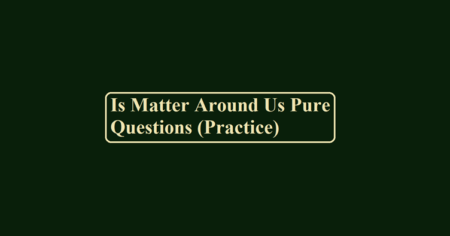Is Matter Around Us Pure Class 9 (Practice – 1 Answer)
Is Matter Around Us Pure Class 9
Ans 1. The net movement of molecules from a region of high concentration to one of lower concentration.
A spray of perfume or room freshener will get diffused into the air by which we can sense the odour.
Ans 2. The matter has three states i.e Solid, Liquid, and Gases.
Ans 3. The smell of hot sizzling food reaches you several meters away, but to get the smell of cold food, we have to go close because the kinetic energy of particles of matter increases with the increase in temperature.
Ans 4. a) When a liquid evaporates it takes latent heat from the object it touches. This will make the object cooler. Hence evaporation causes cooling.
b) When there is an increase in the humidity water vapor in the atmosphere will be more. Hence the atmosphere will not take water vapors easily which decreases the process of evaporation.
c) The sponge is a solid because it has a definite shape and volume which does not change until you press it. It has minute pores in which air is filled. When you press it, air passes out through pores which makes it a compressible solid.
(d) Ice is solid at 0°C because it has a definite volume and definite shape due to strong intermolecular forces. Water is liquid at room temperature because it has a definite volume and no definite shape due to weak intermolecular forces of attraction.
(e) Sugar crystals dissolve faster in hot water than in cold water because hot water molecules have more kinetic energy. Due to this, they strike faster on the particles of sugar than cold water molecules. As a result, hot water will dissolve faster than cold water.
Ans 5. The process of distillation is used for separating the components of a mixture containing two liquids, having different boiling points and both liquids boil without decomposition. The process of fractional distillation is used for separating the components of a mixture containing more than two liquids having boiling point differences of less than 25 K. The basic property that separates these two methods is: Using distillation we can separate only those components which have a significant difference in their boiling points. While fraction distillation is used when the difference in boiling points is less.
Ans 6. This is because of the inter-particle spaces present. In gases, the interparticle space is very large and hence they are compressible, but in the case of solids and liquids particles are close to each other and hence cannot be compressed.
Ans 7. Though ice is a solid it has a large amount of space between its molecules. These spaces are larger as compared to spaces in water molecules. Thus, the volume of ice is greater than water. Hence the density of ice is less than that of water. A substance with low density than water can float on it.
Ans 8. The sample of water under study boils at 102 0C at normal pressure. Hence, the sample is not pure water. Since the sample of water is not pure, it will not freeze at 0 0C. It will freeze at a temperature below 0 0C.
Ans 9. With the help of the following activity, we can prove
(i) Dissolve a few crystals of potassium permanganate in 100 ml of water.
(ii) Take out approximately 10 mL of this solution and add it to 90 mL of clear water taken in another beaker.
(iii) Now from this solution, take 10 ml of the solution and add 90 ml of water taken in another beaker.
(iv) In the same manner Keep diluting the solution like these 5 to 8 times.
From the above activity, we can say that just a few crystals of potassium permanganate can color a large volume of water (about 1000 L).
This activity also proves that matter is made up of tiny particles. So, we conclude that there must be millions of tiny particles in just one crystal of potassium permanganate, which keeps on dividing itself into smaller and smaller particles. Ultimately a stage is reached when the particles cannot divide further into smaller particles.
Ans 10. A tree has a lot of leaves that constantly show transpiration. It is the loss of water through small tiny pores of leaves called stomata. When this water comes to the surface of the leaf the water evaporates by causing a cooling effect. Therefore, we feel pleasant sitting under the tree on a hot sunny day.
Is Matter Around Us Pure Class 9
Ans 11. Ammonia > Alcohol > Solid NaCl
Ans 12. The difference in concentration affects the rate of diffusion. The greater the concentration gradient, the quicker diffusion takes place.
The temperature affects the rate of diffusion.
The surface area of the membrane affects the rate of diffusion.
Distance.
Ans 13. This is due to the fact that in a gaseous state, particles move freely and have greater space between each other as compared to solids and liquids. So, the gaseous particles intermingle or diffuse easily.
Ans 14. (C)
Ans 15. (C)
Ans 16. (C)
Ans 17. (B)
Ans 18. (B)
Ans 19. (D)
Ans 20. (B)
Ans 21. (D)
Ans 22. (B)
Ans 23. (B)
Ans 24. (A)
Ans 25. (B)
Ans 26. (C)
Ans 27. (D)
Ans 28. (A)
Ans 29. (A)
Ans 30. (B)
Is Matter Around Us Pure Class 9

